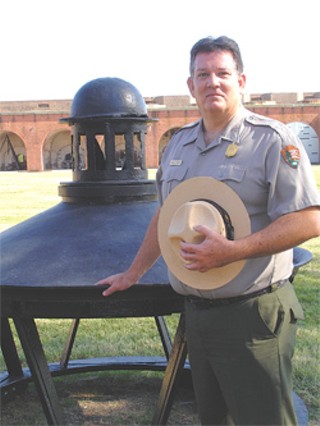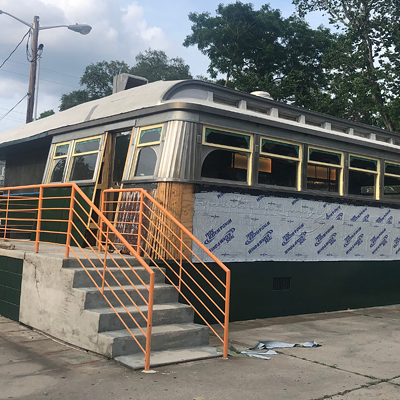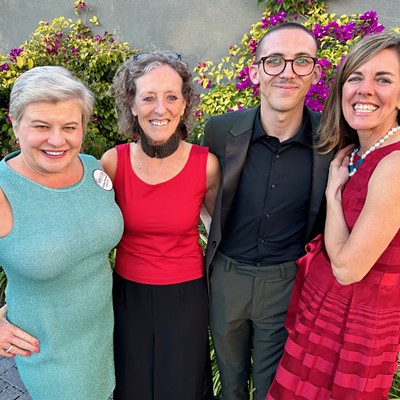FOR OVER 150 YEARS, the Cockspur Island Lighthouse has stood at the mouth of the south channel of the Savannah River, serving as a warning to ships, a witness to history, and a beacon to travelers by water and land.
Despite its survival over the generations, the lighthouse is in a new war that threatens to bring down the historic landmark, the result of an infestation of shipworms eating away at the lighthouse’s wooden foundation. Earlier this month, the Georgia Trust for Historic Preservation placed the lighthouse on its 2008 list of Places in Peril, a warning to government agencies, historians, and the community at large.
“Cockspur Island Lighthouse is the most environmentally threatened of any of the sites,” on the Places in Peril list, says Greg Paxton, president and CEO for the Georgia Trust. “The place where it is located is a big challenge. But it does have interest in getting the restoration done.”
Paxton and others familiar with the project consider being placed on the Places in Peril list a mixed blessing.
“It’s obviously bad news that a place gets put on the list,” says Mark McDonald, executive director of Historic Savannah Foundation.
“It means it has advanced to a level of deterioration that’s of concern for everyone. But it’s good in that it means it’s an important place and it will receive some attention,” he says. “People will be thinking about it more than the many other places in our culture that are slipping between the cracks.”
Cockspur Island Lighthouse is one of five lighthouses remaining in Georgia, significant also because of its role as witness to the attack on Fort Pulaski during the Civil War. On April 10, 1862, Union forces on Tybee Island and Confederate troops in Fort Pulaski waged a 30-hour-long battle, firing mortars at each other across the mouth of the Savannah River, with the lighthouse directly in the line of fire.
“Five thousand rounds going over head, Confederate and Union, and miraculously the lighthouse is unscathed,” says Charles E. Fenwick, superintendent of Fort Pulaski National Monument, which owns the 46-foot tall brick structure perched off the eastern end of Cockspur Island.
“It’s the only thing here today that was here at the time of the battle,” he says.
Since its original construction in 1849, Cockspur Island Lighthouse has been bombarded by forces of water, wind and oxygen. Designed by New York architect John Norris — whose other Savannah work includes the Andrew Low House and the Mercer House — the lighthouse tower was toppled by a hurricane in 1854 just five years after its commissioning.
It was rebuilt in 1856 using Savannah Gray brick. While the structure itself has remained mostly intact since then, the small island underneath it has fared less well. An aerial photo from the late 1980’s shows the land mass about three times larger than the present day island.
Currently, at high tide the land under the lighthouse is completely underwater, as are the first several steps to the lighthouse’s doorway. As the island washes away, it no longer protects the lighthouse foundation from its ocean-borne enemies.
“The wooden base that the lighthouse sits on is exposed to water. It was never intended to be,” says Fenwick. “Shipworms start chomping on the wooden foundation. If the foundation fails then the lighthouse falls into the water. If you deny the shipworms air, you kill the current infestation and prevent future infestation.”
In early 2006, an informal committee convened to work on saving the lighthouse, spearheaded by Cullen Chambers, Executive Director of Tybee Island Historical Society. Two Tybee Island residents “both called me within three days of one another, asking if there was anything we could do,” says Chambers.
“I said unless we could do something on a local level to try to raise awareness and alarm, due to lack of federal funds there wouldn’t be much done. We’d have to take a local initiative to try to do something.”
Chambers enlisted the support of “a network of people we thought would be important to solving this threat,” that includes the two original citizen callers, Tybee Island city council member Paul Wolff, staff for Congressmen Jack Kingston and John Barrow, the Corps of Engineers, County Commissioner Pat Farrell, and Fenwick, who’d become Fort Pulaski’s superintendent only a few months earlier.
The proposed solution is to rebuild a portion of the island, constructing a barrier of rip rap in a ring around the building “to break up some of the wave energy,” combined with “fill material like oyster shell and salt marsh grass to preserve the foundation of the lighthouse,” says Fenwick.
“We want to do, not the minimum, but the least costly solution that is sustainable and will as closely as possible allow the lighthouse to maintain its historic appearance.”
Still in the conceptual stages, the tentative price tag for the project is $1.4 million. Fenwick has requested the funds through the Park Service’s regular funding sources.
“I’m competing with the Grand Canyon, Yellowstone, Yosemite,” he says. “We were the number two priority for the region and placed on a five-year funding cycle” for fiscal year 2011. “The question becomes, can we wait that long?”
Instead of waiting for funds, the committee is investigating other sources. Options include Corps of Engineers funding that requires a local match, and soliciting private contributions.
“It’s kind of like a horse race. Whoever gets there first saves the lighthouse,” says Fenwick.
“The Park Service has moved mountains to facilitate this process,” says Chambers. “I was afraid that given the past lack of funding that they’d resign themselves, that there wouldn’t be much they could do. I was really impressed with Charlie Fenwick’s willingness to step up to the plate in finding some direction for this effort.”
Inclusion on the Places in Peril list is not accompanied by financial or legal incentives, but committee members believe the listing will heighten the public’s awareness of the urgent need for saving the lighthouse.
“Anything that can be done to save it quicker, that’s what I’m interested in,” says Fenwick. “I’m not a marine biologist, I’m a historian, but it’s a matter of years, not decades.” 
To comment e-mail us at [email protected]
Georgia's other 'places in peril'
Here’s the rest of the Georgia Trust's list, with area sites listed first:
Sunbury Historic Colonial Town Site, Sunbury
Founded by the Puritans, the 1758-1864 site of Sunbury was once an important colonial port, trading regionally with Savannah and also with New England and the Caribbean colonies. At one time, this bustling seaport was busier than the port at Savannah. Now high density residential development is nearby and coming closer; ten years ago the historic cemetery was nearly bulldozed. The owner of a critical 40-acre tract agreed to donate it but died before changing his will.
University of Georgia (UGA) Marine Institute and Administration Complex, Sapelo Island
The UGA Marine Institute and Administration Complex on Sapelo Island includes a circa 1925 administrative building and greenhouse structures built by Howard E. Coffin, automobile pioneer and principal landowner of Sapelo Island from 1912-1934. The greenhouses have been abandoned since 1976 and are quickly deteriorating. The administrative building was abandoned in 2004 when UGA closed its doors. It has yet to be mothballed as agreed by UGA in 2004.
Adam-Strain Building, Darien
A rare example of historic tabby construction, the 1813 Adam-Strain Building in Darien was built as a waterfront warehouse, survived looting and fire in 1863, and was refurbished in 1870. Darien has a low tax base and faces strong development pressure. After being denied a demolition permit in 2006, the owner put the building up for sale at a speculative price. Nearby dense residential development and the recent demolition of the eighteenth-century D’Antignac House have caused local concern to reach a new high.
Meriwether County Jail, Greenville
Located just off the courthouse square, the Meriwether County Jail is one of Greenville’s earliest structures. Like many historic county jails statewide, this jail is not capable of serving its original purpose, suffers from deterioration and needs structural attention.
A.L. Miller Senior High School for Girls, Macon
The 1930 A.L. Miller Senior High School for Girls sits in the middle of a historic neighborhood in Macon that is in much need of revitalization. It once served as an important educational center for Winship Heights/Montpelier area, and is owned by the Bibb County Board of Education. Abandoned neighborhood schools have become a statewide problem. Neighborhoods are becoming threatened by these former anchor institutions that now sit vacant, making revitalization more difficult.
Old Clinton Historic District, Gray
Established in 1807, the community of Clinton served as an economic and cultural center for the Georgia frontier. Buildings date from 1808-1835 and together provide a rare example of a largely intact Georgia rural frontier village that combines commercial and residential structures. The corridor of the south side of US 129 has been lined with strip commercial development within the last 10 years. Recently the city approved a bypass that will come within several hundred yards of the district.
Spencer House, Columbus
The Spencer House is the 1912 home of William H. Spencer, Columbus’ first Superintendent of Colored Schools, who worked tirelessly to establish an accredited high school for African American students in Columbus. His goal was ultimately achieved when Spencer High School was built in 1930, five years after his death. The house is currently part of Columbus’ African American heritage tour and is owned by the Owlettes, Spencer High’s alumnae association. However, the Owlettes are dwindling as the group grows older.
Trinity C.M.E. Church, Augusta
Constructed in Augusta between 1889-1894, Trinity Church is the mother church of the Christian Methodist Episcopal (CME) denomination in the United States. Remodeled in 1920-1923, it is the last remaining building in a historic 19th-century African American neighborhood. The building is vacant and deteriorating and is located near a portion of the Augusta Canal that is marked to be redeveloped. The area surrounding the church has already been cleared for development.
The Castle, Atlanta
Built 1909-1910 by Ferdinand McMillan as his retirement home, The Castle adjoins large Midtown office buildings and the Woodruff Arts Center on Atlanta’s Peachtree and 15th Streets. Threatened with demolition in the mid-1980s, the building was called “a hunk of junk” by Atlanta Mayor Andrew Young in June 1986, sparking the strengthening of the local preservation ordinance. There is little activity at the property as it stands empty and deteriorating. Purchased in 2002 for $1 million, the property currently has a $4 million asking price. 
Source: Georgia Trust for Historic Preservation (www.georgiatrust.org)































